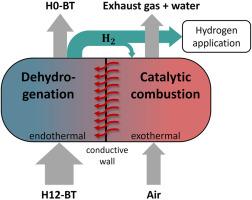采用新型紧凑型自热反应器,以催化氢燃烧为热源对液态有机氢载体进行脱氢
IF 8.3
2区 工程技术
Q1 CHEMISTRY, PHYSICAL
引用次数: 0
摘要
讨论了由过氢苄基甲苯(H12-BT)脱氢室和热接触催化氢燃烧(CHC)室组成的自热释氢装置的实验性能。具体来说,应用装置包括基于7根平行管的多管CHC加热,反应器外壳含有商业脱氢催化剂。这样,CHC利用脱氢过程中产生的一部分氢对吸热式LOHC脱氢进行加热。与最先进的加热概念相比,提出的自热LOHC脱氢加热概念具有几个优点,包括最小的空间消耗、高效率和零氮氧化物排放。在性能测试中,该工艺达到了37%的最小氢燃烧分数,而工业规模装置脱氢反应的最小热需求为33%。反应器的方向(垂直vs水平)和流动配置(逆流vs共流)对性能的影响很小,这表明所提出的反应器设计的稳健性。本文章由计算机程序翻译,如有差异,请以英文原文为准。

Catalytic hydrogen combustion as heat source for the dehydrogenation of liquid organic hydrogen carriers using a novel compact autothermal reactor
The experimental performance of an autothermal hydrogen release unit comprising a perhydro benzyltoluene (H12-BT) dehydrogenation chamber and a catalytic hydrogen combustion (CHC) chamber in thermal contact is discussed. In detail, the applied set-up comprised a multi-tubular CHC heating based on seven parallel tubes with the reactor shell containing a commercial dehydrogenation catalyst. In this way, the CHC heated the endothermal LOHC dehydrogenation using a part of the hydrogen generated in the dehydrogenation. The proposed heating concept for autothermal LOHC dehydrogenation offers several advantages over state-of-the-art heating concepts, including minimized space consumption, high efficiency, and zero NOx emissions. During performance tests the process reached a minimum hydrogen combustion fraction of 37 %, while the minimum heat requirement for the dehydrogenation reaction for industrial scale plants is 33 %. The reactor orientation (vertical vs horizontal) and the flow configuration (counter-current vs. co-current) showed very little influence on the performance demonstrating the robustness of the proposed reactor design.
求助全文
通过发布文献求助,成功后即可免费获取论文全文。
去求助
来源期刊

International Journal of Hydrogen Energy
工程技术-环境科学
CiteScore
13.50
自引率
25.00%
发文量
3502
审稿时长
60 days
期刊介绍:
The objective of the International Journal of Hydrogen Energy is to facilitate the exchange of new ideas, technological advancements, and research findings in the field of Hydrogen Energy among scientists and engineers worldwide. This journal showcases original research, both analytical and experimental, covering various aspects of Hydrogen Energy. These include production, storage, transmission, utilization, enabling technologies, environmental impact, economic considerations, and global perspectives on hydrogen and its carriers such as NH3, CH4, alcohols, etc.
The utilization aspect encompasses various methods such as thermochemical (combustion), photochemical, electrochemical (fuel cells), and nuclear conversion of hydrogen, hydrogen isotopes, and hydrogen carriers into thermal, mechanical, and electrical energies. The applications of these energies can be found in transportation (including aerospace), industrial, commercial, and residential sectors.
 求助内容:
求助内容: 应助结果提醒方式:
应助结果提醒方式:


